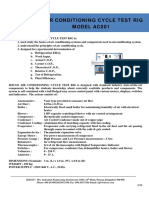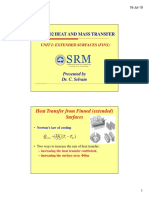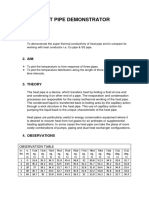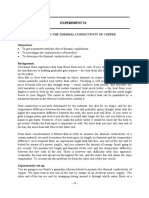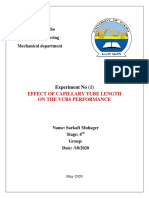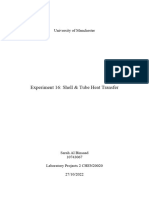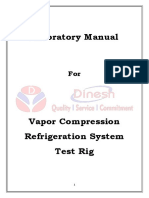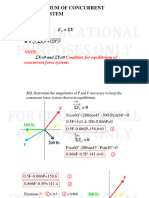Forced Convection Apparatus
Uploaded by
Ashish VermaForced Convection Apparatus
Uploaded by
Ashish Verma1 Beat Tiansfei Laboiatoiy
DINESH SCIENTIFIC
Forced Convection Apparatus
Object:
To determine the Forced Convection heat transfer coefficient for flow through
the given horizontal tube.
Introduction:
Convection is a process of energy transfer by the combined action of heat
conduction, energy storage and mixing motion. When the mixing motion in
induced by some external agency such as pump or a blower the process is
called forced convection. The intensity of the mixing motion is generally high in
forced convection and consequently the heat transfer coefficient is higher than
free convection. The heat transfer coefficient h can be obtained from Newton
Rockmens law of convection i:e
q = h A T
Experimental Setup:
The experimental setup consists of a blower unit fitted with test pipe. The test
section is surrounded by Nichrome wire band heater.
Temperature Indicator
Voltmeter
Ammeter
Heater On/Off
Dimmerstat
Manometer
Supply On/Off
Orificemeter (k = 0.82)
Air Blower for
Creating Forced
Convection Effect
Housing of Test Pipe
2 Beat Tiansfei Laboiatoiy
DINESH SCIENTIFIC
Experimental Procedure:
1. Switch on the supply and select the range of heater using dimmerstat.
2. Now adjust the flow of air using the control rotor on the air blower unit
to some value.
3. Wait till the steady state is reached.
4. Note the ammeter, voltmeter and thermocouple temperatures, from T1 to
T
5.
5. Now change the manometer difference to next value and repeat the
experiment.
6. Calculate the heat transfer coefficient using newton formula.
7. Also calculate the h using the relation
Nu = C (Re)
m
(Pr)
n
Pr = Prandtl Number = Cp / kair = 0.708 (from Data Book)
Or, Heat Transfer coefficient
h = (Nu k
air
) / L
c
Specifications:
1. Pipe outer diameter = 38 mm
2. Pipe inner diameter = 34 mm
3. Length of Test Section = 300mm
4. Orificemeter diameter = 11.2 mm
Observation Table:
S.No
Heater Input
Manometer
Reading
H = h1 + h2
x 10
-3
m
Thermocouple reading
V I T
1
T
1
T
2
T
3
T
4
T
5
1
2
3
4
5
3 Beat Tiansfei Laboiatoiy
DINESH SCIENTIFIC
Calculations:
Experimental Method
1. Rate of Heat transfer coefficient Q = V x I
2. Heat Transfer Coefficient, h = Q/A(T
s
T
a
)
Q= V I = W, watts
A = Surface area of Brass tube = dL
d= Inner diameter of pipe = 34mm
L= 30mm
T
s
=
T2+ T3+ T4
3
= . K
Ta =
T1+ T5
2
= . K
Theoretical Method
1. The standard value of air at Ta =
T1+ T5
2
= 300 K
a = 1.1774 kg/m
3
= 1.983 x 1
-5
kg/ms
Cp = 1.0059 kJ/kg K
kair = 0.02624 kW/mK
w = 1000 kg/m
3
2. Heat of air H
a
=
w
h
w
/
a
a
= 1.1774 kg/m
3
w = 1000 kg/m
3
h
w
= Heat of water in (m)
3. Discharge of air, q = C
d
x x d
o
2
/4 2gEo
d
o
=
Orificemeter diameter = 11.2 mm
Cd = Co-efficient of discharge = 0.82
Velocity V= Discharge / Area of tube = q/A (m/s)
A= x di
2
/4, di = inner diameter of tube through
which air flows
Reynolds number, R
e
= . V. L /
Nu = C (Re)
m
(Pr)
n
From data book for flow through data book
N
u
= 0.023 (R
e
)
0.8
(Pr)
0.33
You might also like
- My Notes For Edx 8.02x "Electricity and Magnetism"83% (6)My Notes For Edx 8.02x "Electricity and Magnetism"283 pages
- Experiment No. 4 Forced Convection Heat Transfer From A Flat Plate To Air 1No ratings yetExperiment No. 4 Forced Convection Heat Transfer From A Flat Plate To Air 13 pages
- MAK 302L Experiment 3 Extended Surface Heat Transfer 1. PurposeNo ratings yetMAK 302L Experiment 3 Extended Surface Heat Transfer 1. Purpose5 pages
- Project On Three Phase Fault Analysis With Auto Reset On Temporary Fault and Permanent Trip Otherwise100% (21)Project On Three Phase Fault Analysis With Auto Reset On Temporary Fault and Permanent Trip Otherwise34 pages
- Richardson Zaki Sedimentation and Fluidisation Part I PDFNo ratings yetRichardson Zaki Sedimentation and Fluidisation Part I PDF19 pages
- Free/Force Convection H.T From Pinned&finnedNo ratings yetFree/Force Convection H.T From Pinned&finned14 pages
- Combined Convection and Radiation Mechanical Engineering ThermoNo ratings yetCombined Convection and Radiation Mechanical Engineering Thermo15 pages
- Equipment For Engineering Education: G.U.N.T. Gerätebau GMBHNo ratings yetEquipment For Engineering Education: G.U.N.T. Gerätebau GMBH38 pages
- Heat Pump (Heating) : Experiment No. (2) Mechanical LabNo ratings yetHeat Pump (Heating) : Experiment No. (2) Mechanical Lab16 pages
- University of Zakho College of Engineering Mechanical DepartmentNo ratings yetUniversity of Zakho College of Engineering Mechanical Department22 pages
- TD1005 Free and Forced Convection DatasheetNo ratings yetTD1005 Free and Forced Convection Datasheet3 pages
- Exp. 2 HEAT TRASFER IN NATURAL CONVECTIONNo ratings yetExp. 2 HEAT TRASFER IN NATURAL CONVECTION5 pages
- Measuring The Thermal Conductivity of CopperNo ratings yetMeasuring The Thermal Conductivity of Copper4 pages
- Experiment 11 - Thermal Conductivity of Insulating PowdersNo ratings yetExperiment 11 - Thermal Conductivity of Insulating Powders9 pages
- University of Zakho College of Engineering Mechanical DepartmentNo ratings yetUniversity of Zakho College of Engineering Mechanical Department14 pages
- Exp 6 Free & Forced Convection Heat Exchanger50% (2)Exp 6 Free & Forced Convection Heat Exchanger19 pages
- Operating Instructions FOR Determination of Aggregate Impact Value ApparatusNo ratings yetOperating Instructions FOR Determination of Aggregate Impact Value Apparatus2 pages
- Universal Testing Machine-Computersied Lab ManualNo ratings yetUniversal Testing Machine-Computersied Lab Manual12 pages
- Laboratory Manual: Core Drilling MachineNo ratings yetLaboratory Manual: Core Drilling Machine5 pages
- Laboratory Manual: Core Cutting Grinding MachineNo ratings yetLaboratory Manual: Core Cutting Grinding Machine6 pages
- Oscilloscope C.R.O 20Mhz MTQ 5020 / 5020 C: FeatureNo ratings yetOscilloscope C.R.O 20Mhz MTQ 5020 / 5020 C: Feature1 page
- Profile Projector: Dynamics of Machine LaboratoryNo ratings yetProfile Projector: Dynamics of Machine Laboratory4 pages
- Vapor Compression Refrigeration Test Rig Computerised Lab Manual50% (2)Vapor Compression Refrigeration Test Rig Computerised Lab Manual12 pages
- Vapor Compression Refrigeration Test Rig Lab Manual LatestNo ratings yetVapor Compression Refrigeration Test Rig Lab Manual Latest12 pages
- A Generalized Flow Prediction Method For The Unsteady Flow Generated by A Train in A Single-Track TunnelNo ratings yetA Generalized Flow Prediction Method For The Unsteady Flow Generated by A Train in A Single-Track Tunnel30 pages
- Civil Engineering Fluids Statics DynamicsNo ratings yetCivil Engineering Fluids Statics Dynamics1 page
- B.Tech. I /II Semester (Common To All Branches) Met-103 Manufacturing ProcessesNo ratings yetB.Tech. I /II Semester (Common To All Branches) Met-103 Manufacturing Processes144 pages
- Mulliken Symbols For Irreducible Representations100% (1)Mulliken Symbols For Irreducible Representations2 pages
- Esa Eso Hubble Space Telescope Educational Material - Hubble 15 Year of Discovery (English) Series 0.1 - BookNo ratings yetEsa Eso Hubble Space Telescope Educational Material - Hubble 15 Year of Discovery (English) Series 0.1 - Book22 pages
- Ley de Kirchhoff: Eddy Gutierrez Ayala, Yessica Nancy Puri ChoqueNo ratings yetLey de Kirchhoff: Eddy Gutierrez Ayala, Yessica Nancy Puri Choque3 pages



